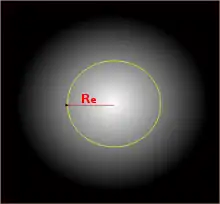
Half light radius Re encloses half of the total light emitted by an object
Galaxy effective radius or half-light radius () is the radius at which half of the total light of a galaxy is emitted.[1][2] This assumes the galaxy has either intrinsic spherical symmetry or is at least circularly symmetric as viewed in the plane of the sky. Alternatively, a half-light contour, or isophote, may be used for spherically and circularly asymmetric objects.
is an important length scale in term in de Vaucouleurs law,[3] which characterizes a specific rate at which surface brightness decreases as a function of radius:
where is the surface brightness at . At ,
Thus, the central surface brightness is approximately .
See also
References
- ↑ "Half-light Radius". Swinburne University. Retrieved 22 May 2013.
- ↑ Binney, James; Tremaine, Scott (2008). Galactic Dynamics (Second ed.). Princeton Series in Astrophysics. p. 21. ISBN 9780691130279.
- ↑ Mazure, Alain (15 February 2002). "Exact solutions for the spatial de Vaucouleurs and Sérsic laws and related quantities" (PDF). Astronomy & Astrophysics. 383 (2): 384–389. arXiv:astro-ph/0112147. Bibcode:2002A&A...383..384M. doi:10.1051/0004-6361:20011751. S2CID 17651247.
This article is issued from Wikipedia. The text is licensed under Creative Commons - Attribution - Sharealike. Additional terms may apply for the media files.